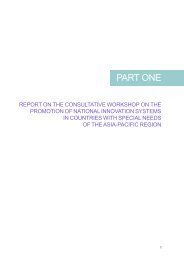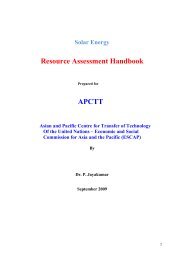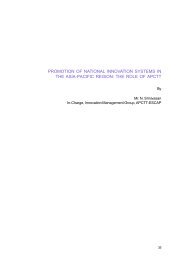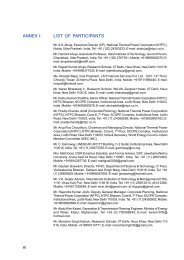Download Complete PDF - apctt
Download Complete PDF - apctt
Download Complete PDF - apctt
- No tags were found...
Create successful ePaper yourself
Turn your PDF publications into a flip-book with our unique Google optimized e-Paper software.
ANNEX VIII:SWOT ANALYSIS OF FOSSIL FUEL TECHNOLOGYByMr. A.K. SinhaGeneral Manager (PE)National Thermal Power Corporation (NTPC)Noida, IndiaThe International Energy Agency (IEA) has made the following projections for 2035:• Rising fossil energy use will lead to irreversible and potentially catastrophic climatechange;• Global energy-related carbon dioxide (CO 2) emissions will peak before 2020 andthen decline to 21.6 Gt by 2035;• Carbon capture and storage (CCS) is a likely abatement option (efficacy yet to beproven), accounting for 18 per cent of emissions savings;• Coal is the most abundant fossil fuel globally, with reserves totaling 1 trillion tonnes(lasting about 150 years at the current production level);• Fossil fuel consumption subsidies worldwide amounted to US$409 billion in 2010,with subsidies to oil products representing almost half of the total;• By encouraging deployment, renewable energy subsidies can help cut greenhousegas emissions; and• Unconventional gas – shale gas and coal-bed methane – is set to play an increasinglyimportant role.The global energy demand is expected to increase by one-third from 2010 to 2035,with China and India accounting for 50 per cent of the growth (Figure 3-16).Energy (mtoe)Figure 3-16: Growth in global primary energy demand4,5004,0003,500China3,0002,500India2,000Other developing Asia1,500Russia1,000Middle East500Rest of the world0OECD2010 2015 2020 2025 2030 2035Years(Source: World Energy Organization, 2011)







